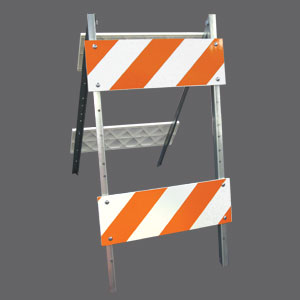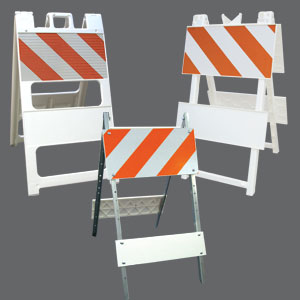The Ultimate Barricade Guide
Barricade Types
Knowing which barricade to use can be a bit tricky, as there are quite a few variables to sort through. First let’s look at the different options and their applications:
Type I Barricade: Has reflective sheeting on the upper half of the barricade, and not the lower. They are ideal for pedestrian traffic and other types of control where maximum reflective sheeting is not needed. Since reflective sheeting can be the most expensive part of the barricades, Type I barricades tend to have a lower price.

Type II Barricade: Has reflective sheeting on the upper and lower boards of the barricade. They are most often used on roads that have detours or closings, as well as other types of control that require maximum reflective sheeting. Type II’s are smaller than Type III’s, making them ideal in situations with limited space.

Type III Barricade: Has three reflective boards, all with sheeting. They are able to block entire lanes of traffic, making them ideal for road closers or detours. Although they may be tricky to store due to their size, there are collapsible options available with 4’,6’,8’ and 10’ boards.
Other types of products used for traffic and crowd control are: A-Frame Barricades, Concrete Barriers, Safety Barricades, Steel Barricades and Water Filled Barricades. Make sure to fully understand the proper application before purchasing and using each product.
Barricade Material

 When choosing between barricades, you generally have two options with the make: plastic barricades or steel legs with plastic boards.
When choosing between barricades, you generally have two options with the make: plastic barricades or steel legs with plastic boards.
Plastic Barricades: Economical, strong and stack-able. The legs and board are molded into one piece, it never rusts or needs painting, and the legs never need straightening.
Steel Legs: Boards can be replaced and legs can be repaired. Steel is strong and dense, wont warp.
Sheeting
Depending on your state codes, particular sheeting may be required on your barricades.
Engineering Grade (EG): The least effective sheeting, used in less serious situations. It has the lowest shelf life and can be difficult to remove once applied with adhesives.
High Intensity Prismatic (HIP): More reflective and effective than EG, often times used on standard road signs as well as traffic safety devices. It is reflective during the day and at night, and protects against scratches and other forms of tear. Although HIP sheeting is not as effective as Diamond Grade, the difference in price is appealing.
Diamond Grade (DG): The most reflective sheeting, required in many states for most applications. It can be seen from greater distances and is superior to its alternatives in every category besides price. Still, when it comes to traffic and pedestrian safety, price becomes of less importance.
Orange and white stripes are used in almost every circumstance, however red and white stripes may be used at the dead end of roads or where permanent closings are marked.
Placement
Our barricades are sheeted to have both right and left facing sheeting on opposite sides.
Right Barricade: placed on the right side of the road, as traffic passes to its left. The orange and white sheeting should be sloping downwards from right to left.
Left Barricade: placed on the left side of the road, as traffic passes to its right. The orange and white sheeting should be slopping downwards from left to right.





